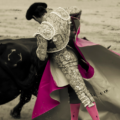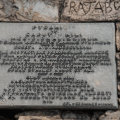Travels with My Daughter: the Himalayas

In October ’72 my ten-year-old daughter, Veronica, and I attempted to fly from Kathmandu to Lukla for the Khumbu trek to Thangyboche monastery, which lies at over 12,600 ft., across the saddle of a mountain facing Mount Everest (Sagermatha) and the valley south of it.
At home in an outlying area of Kathmandu, we awoke at dawn several mornings in a row and walked the usual mile into town to seek a cab for the 20-minute ride to the airport. Each time we reached the airport’s Royal Nepal Airlines counter only to be told that all flights were cancelled due to fog. On the third morning we cabbed it to the airport again, this time both sleep-deprived and famished as we were late, but the skies were clear enough, and we climbed the outdoor stairs to a single-prop Rolls Royce plane seating about ten people, the most elegant plane I’d ever flown.
What followed was a dream-like hour over the glittering snow peaks of eastern Nepal’s Solu Khumbu region. We wondered how this plane could land among the rocky peaks below, and somewhere near the steep crevices approaching Lukla (the name means “goat-pasture”), we looked down and realized we could see no landing possibilities whatsoever. Only a web of canyons cutting miles deep among raging torrents.
The pilot circled down slowly between the sheer precipices of a canyon that seemed too narrow for smaller circles. I leaned into the aisle to see through the front cockpit window. Massive granite walls loomed far too close in every direction. The plane veered, closing in on rock walls again and again as the pilot banked into and out of spirals and descended, neatly averting what seemed inevitable. We descended from 25,000 feet in this absurd manner and finally managed to land on a ledge that turned out to be 8,800 feet high: the perilously short airstrip and a few scattered houses called Lukla.
The green Himalayan ledge which held the airstrip was banked upward toward the rising mountain so every landing was necessarily slowed due to the uphill slope of the ledge, and every takeoff was similarly accelerated by the downhill slope of the ledge into thin air.
As we exited the plane we could see a few traditional Khumbu stone houses with thatched roofs, some built on a slope with a steep stoop unadorned with such amenities as banisters. On the top step of one of these stoops, in front of the doorway, a Sherpa woman was calling “Alu! Alu!” (“Potatoes!”): the local way to announce a breakfast of tiny high-altitude potatoes (the sole item available, except for Tibetan tea). Veronica took off for the house, running right through the front door and headed for the kitchen. But in the blindness of the passage from brilliant sunshine into a very dark interior, she failed to notice the slate stairway going down to the basement directly inside the door, and tumbled down the stairs headlong.
The Sherpa woman let out a little cry. Veronica was unconscious, her mouth streaming blood, lying on the stone stairs in the dark. I couldn’t think and must have been in a mild state of shock, having no idea how to handle an emergency in this remote area. One of the local Sherpas carried my daughter up the stairs and laid her on the ground outside. I felt her arms and legs, her head and torso, for broken bones. There was blood on her face, her lip had a deep cut and several of her teeth were broken. Days of preparations for the high-altitude Khumbu trek had come to this. I tried to stop the bleeding from her mouth wound with a cotton scarf.
The Sherpa who carried her out into the bright daylight put two bamboo sticks in the ground on one side of her, toward the early morning sun, and then placed a cloth over the sticks to give her shade. I tried to revive her by pouring cold water from my canteen on a cloth and patting her face, but she did not come around. I began to weep silently. The local Sherpas gathered around us, about eight of them, and were stunned to see tears roll down my face. They’d probably never seen a Western woman shed tears before, and seemed shocked at that fact, not at my injured child. One woman in particular watched, perhaps relieved to see that Injis (Nepal’s term for Westerners, long ago derived from “English”) might be more tender-hearted than she’d been aware.
After 20 minutes Veronica regained consciousness. I rinsed her mouth gently and carried her into the same house for tea and curried potatoes.
Her lip had a jagged deep cut and the Sherpas explained our two choices. I spoke some Tibetan and the rest was sign language and Pidgin English: we could fly back to Kathmandu with the plane’s return trip within an hour. There was only one flight each day in this trekking season, and even that was iffy. Or we could trek up to the small, high village of Kunde to the hospital —the one founded by Sir Edmund Hillary after his conquest of Everest—a half-day’s walk away. One tall and sturdy Sherpa woman offered to carry Veronica to the hospital, and another local woman offered to carry both our backpacks. When I determined with my sketchy Tibetan/Sherpa vocabulary that the doctor up there was from New Zealand, I realized not returning to Kathmandu was the optimum choice, and agreed almost immediately.
This was not on the main trail to Everest from Lukla, but a detour, about a five-hour trek to Kunde and the hospital. We set out up a steep switchback trail up the back of Lukla rather than the regular trail to Everest, but after the first half-hour piggybacked on the Sherpa woman’s back, Veronica volunteered to walk. Her head felt better but the wounds in her mouth hurt.
After a half-day’s trek we reached the hospital. It turned out to be a few attached rooms, motel-like, on abandoned premises. Not a doctor or nurse to be seen, precious little equipment, and no patients. Eventually we found a woman waiting nearby. With another attempt at basic Tibetan I learned the doctor would soon return. After an hour or so he arrived and examined Veronica. If we’d gotten there sooner, he said, he would have stitched the wound, but now it was too late. It was becoming infected. He gave her antibiotics and told us we should remain in Kunde, 13,000 feet high and home to him and his wife during his term as the Hillary Foundation doctor, for a few days so he could observe and be sure Veronica healed properly. He was the only doctor, in fact the only member of the spare staff who had any training in Western medicine at all, at the hospital.
The doctor had certain accommodations in mind for us, and accompanied us to the house of the village head-man, Mingma, a rugged, hale Sherpa who had been the head Sherpa on the Hillary expedition in the 1950s. Mingma and his family welcomed us with warmth and hospitality. He spoke some English as well. The eyes speak more clearly in those high altitudes and things of the spirit and material world seem to be understood more easily there. The concept of sacred high peaks was immediately contagious.
Each morning and night we had our meals with Mingma’s family. Our quarters were in a private room that adjoined the side of his house but had their own entrance. It had its own iron, wood-burning stove which, no matter how many matches I used, would not stay lit for more than a few minutes. There simply wasn’t enough oxygen at this 13,100-foot altitude. I had to ask one of Mingma’s sons for help lighting the fire: not a terrific defeat but one nonetheless. He managed to get the fire going with an old leather bellows and additional logs, but it went out within the hour. Veronica and I crawled into our down bags and slept deeply for a few hours.
About three in the morning I heard loud crunching noises outside. I peered through the one tiny window and made out several huge yak. They were in the turnip field directly outside our door a few feet from where I stood, in a small field fenced in with rock walls that was our front yard. We’d climbed the wall to get to our cabin; the yak had no trouble doing likewise, evidently crashing their way through the piled rocks. I thought the only decent thing to do was to notify Mingma’s family, but how? I’d have to dart past the huge creatures with horns like longhorn cattle. Veronica was sound asleep, and one accident per trip was plenty. Still, this couldn’t be right. The yak could eat a month’s supply of turnips in one meal—if the meal ever ended. They seemed to graze all day—and now all night—to maintain their tonnage.
I felt such a burdensome responsibility about maintaining Mingma’s small turnip crop that I made a dash for the door to the main house. The yak barely acknowledged me. The door was locked for the night, so I was reduced to banging on the heavy wood door and shouting up to the closed shutters on the second floor of the stone house. I had no idea what the Tibetan for “turnip” was, didn’t know any word for “vegetable” and had seen none at meals except for the potato, so I used the Nepali term for cooked vegetables, “sobjee.” I shouted for Mingma quite a while, determined to save his family’s long-term food supplies.
Eventually, one of the sons popped his head out of a wooden shutter. They had no idea what I was shouting. I created a sentence out of Tibetan and Nepali — it must have been a good laugh for Mingma’s family: “The yak are eating” (in Tibetan) and “vegetables” (in Nepali). I later understood that “sobjee” meant only cooked vegetables. Mingma’s son looked at me quizzically, glanced at the yak, then shouted down in Tibetan, Go back to sleep! And closed the shutter.
That was all. The stunning revelation came to me that perhaps the yak were meant to eat the turnips at night. Perhaps they were meant to crash through the low wall and eat the turnips.
The next day there was laughter all around, and no one said much about the turnips in explanation. Mingma’s English was not sufficient and neither was my Tibetan. One had to divine the meaning of the smiles. Perhaps they were grateful that I was well-meaning, yet another one of the peculiar foreign fools. One had to conjecture the turnips were as much yak food as human food.
One evening several 40- or 50-something village men, Sherpas, sat with us after dinner. We talked for a while in basic Tibetan, helped along by Mingma’s half-forgotten English, about my work teaching English in Kathmandu and my impressions of Nepal. After a while, one of the men pulled a stack of painted deities—small paintings not much larger than playing cards—from the pouch in the front of his chuba, a pouch created by a belt and one front flap of the coat-like garment. This is the traditional place for carrying a few valuables and necessities like a small wooden bowl, rupees, possibly some food. He proffered the ancient-looking hand-painted images on 2-inch by 3-inch bits of canvass and let me examine them in the customary half-light of these houses (no electricity of course, only yak-butter lamps or candles) while his Kunde friends watched. Each card depicted a different Tibetan Buddhist deity: the Buddha of the east, the Buddha of the west, the protective deities, and so on. Despite their miniature size, the detail was intricate. I spent some time admiring the work and asking about several of them, and one of the men asked which ones I liked best. I took my time answering and then chose three—Chenrezi, the god of compassion, Amitabha, the Buddha of infinite light, and Amoghasiddhi, “he whose accomplishment is not in vain.” When I moved to return the images to him, he immediately motioned that I should keep these three tiny tanka paintings. I was quite moved, and he seemed happy that I was; they all glowed with deep smiles. I realized the images were suitable for traveling, and they were protective images. I’ve never let them go.
In the daylight we walked, visited the doctor again, and gazed at the ice peaks towering over us. The silence was enormous and in the thinness of the air there was an otherworldly, distant ringing, always there when there were no voices or yak or dogs to be heard. It was a continual mystery to me. The houses were made of wood or stone with slate roofs and different from the Tibetan-style monastery architecture, which was so much more elaborate, including wood galleries, carved and painted beams, and broad entryways on inner courtyards. The houses were all two stories with sheep or goats housed on the entrance floor in one section, and storage in another part of the earth floor. There was no plumbing; water was carried in from a creek or rushing river. Stone storage buildings were common (wood was reserved mostly for burning here, not building) and as it was October, the potato harvest was already in. Turnips were drying in the sun, still on the fields, and what was left over from the beasts’ midnight feeds would go to the humans. Oddly enough, Mingma’s sons chased the yak out of the turnip field in the mornings, but they were allowed to dine in style in the wee hours.
The method of chasing a yak involves throwing small stones at their thick, oily fur. The yak evidently feel nothing at all, but eventually they move. Ten to 16-year-old boys astounded me by going into a yak pen (seldom used and quite crowded), sitting on their backs, and then stepping or leaping from back to back with glee at their own prowess. It was a game they loved. I asked Mingma if this was safe, and he said “Min du,” meaning No. Nothing more.
“They could be hurt,” I prompted, using my hands as yak horns and tossing my head. He nodded and gave a slight shrug, an all but imperceptible smile—his eyes shone. This is part of life here. The boys love a challenge and they need to learn: this was said without words. We used sign language and my insufficient Tibetan. Sherpas are Tibetans who came to Khumbu many generations previously, and they do not dwell on the negative, or injuries, and certainly not death. It passes. Their sons and daughters learn to be at home with the yak and not be afraid. If they are injured, it’s a rare occurrence. Perhaps recovery is easier in this more germ-free environment. I saw the memory of a wounded boy in his eyes, but no more was said of it.
About Terese Coe
Terese Coe's poems, stories, and translations have appeared in Agenda UK, Alaska Quarterly Review, Cincinnati Review, Hopkins Review, The Moth (Ireland), New American Writing, Ploughshares, Poetry, Poetry Review UK, Threepenny Review, the TLS, and dozens of other European and American literary journals.





